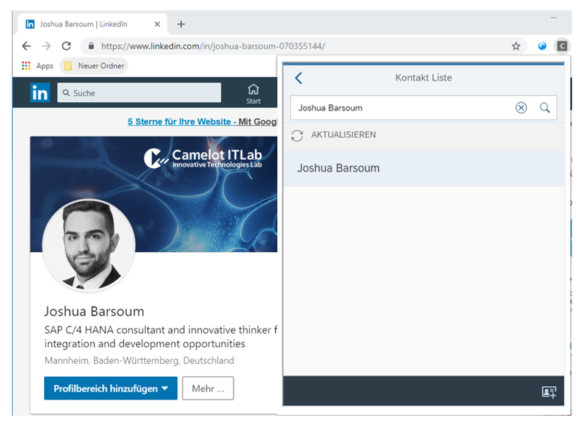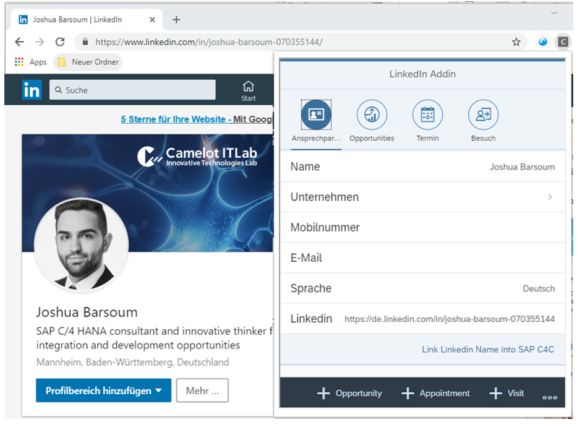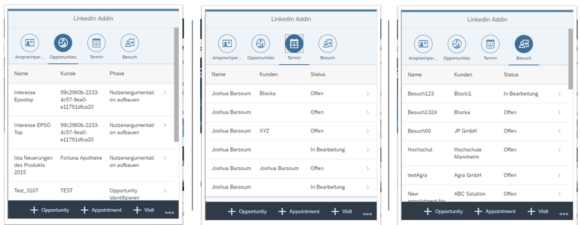Here you will find an updated article on the topic from 2022.
In our last blog post, we talked about the integration of social media channels like Twitter in SAP C/4HANA. In this article, we will discuss connecting the SAP Sales Cloud, which is part of the C/4HANA portfolio, with the most common business networks, since the number of LinkedIn and XING users is continuously growing.
Both of these social media networks are referred to as business networks, since this is where users maintain their professional networks and business contacts. LinkedIn and XING used all over the world [1].
Businesses are also increasingly taking advantage of business networks, as well as using them for recruiting personnel or establishing (customer) contact, for example.
The Sales Cloud is used to maintain the details of contact persons, among other things. However, the reconciliation of records must currently be completed manually. And it is of course possible that not all of the records are available when needed, or some become outdated over time. Networks are therefore often also used here to update missing or existing information. To do this, the contact details have to be searched for and opened in LinkedIn / Xing as well as in the Sales Cloud. The creation of contact persons and the associated activities, such as appointments and tasks, are additional, manual processes that may then also be necessary.
How can this process be made more efficient?
In order to establish a perfect, seamless process for business networks in connection with SAP Sales Cloud, we have developed an extension for the Chrome browser – the Business Network plug-in for LinkedIn and Xing. With the LinkedIn plug-in, it is possible to directly check in the LinkedIn application whether the person found already exists in the C4C of the SAP Sales Cloud. Following installation, it can be displayed by clicking the right-hand side of the browser.
It is then possible to determine within seconds whether this contact exists in the Sales Cloud. If no contact is found, the “Create Contact” function can be used to immediately create the person via the application. The contact information is filled in manually, as is usual in the Sales Cloud. When creating the new contact, it goes without saying that the applicable data privacy rules of the company must be taken into consideration.
If a contact person is found, however, the contact-related information will be displayed on the screen of the application. The LinkedIn profile can be linked to the Sales Cloud contact person at the push of a button.
The application also enables you to display, create and edit appointments, opportunities and visits in an overview for this contact person. If you open one of these objects, you can see more information about it. Furthermore, the LinkedIn plug-in allows you to edit the activities, such as information about the start and end time of an appointment. The new values are then automatically updated in the Sales Cloud. What’s more, you can also create opportunities, appointments and visits for the contact person via the application. The created objects are replicated to the Sales Cloud.
To sum it up, the LinkedIn plug-in allows you to work more efficiently with the business network.
Benefits at a glance:
- Increased efficiency when searching for and creating contact persons
- Improved data quality by linking the business networks LinkedIn and Xing
- All opportunities, appointments and visits for the contact person at a glance
- Editing planned opportunities, appointments and visits
- Create opportunities, appointments and visits for the existing contacts
- No need to open other systems – everything is controlled centrally
- A flat and rapid solution for supporting everyday tasks
If you are interested in using the plug-in, or would like further information, please don’t hesitate to contact us.
[1] https://www.kontor4.de/beitrag/aktuelle-social-media-nutzerzahlen.html As of 3/11/2019





